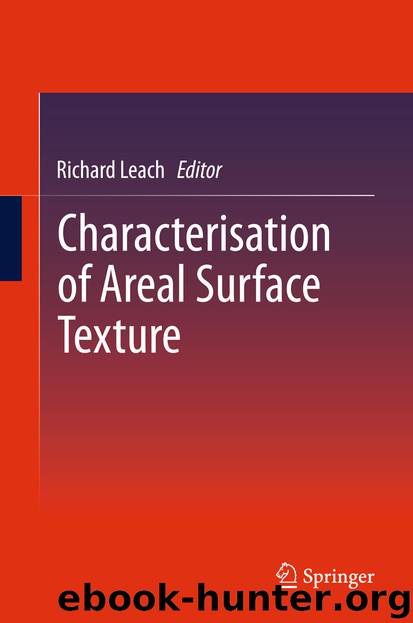Characterisation of Areal Surface Texture by Richard Leach

Author:Richard Leach
Language: eng
Format: epub
Publisher: Springer Berlin Heidelberg, Berlin, Heidelberg
8.1 Surface Metrology and the Characterisation of Individual Areal Features
Surface metrology is conventionally concerned with the characterisation of surface finish. Once form has been removed from an areal topography dataset, the remaining information is surface texture, which is described over the entire scale-limited surface (see Chap. 2). For this reason, the recent ISO 25178 part 2 (2012) standard stresses the concept of field parameters, i.e. parameters that define surface texture over the entire scale-limited surface (Chap. 2, Blateyron 2006; Jiang et al. 2007). ISO 25178 part 2 also refers to feature parameters, which are computed by aggregating attributes (area, perimeter, depth, etc.) originally extracted from individual topographic features (Maxwellian hills and dales) (Chap. 3, Scott 2004). However, feature parameters are still representative of topographic properties which pertain to the entire surface.
In spite of the conventional approach, there is a strong and growing interest in the characterisation of individual areal surface features considered as standalone entities, i.e. without the need to revert the results back into an indication of the overall surface state. For the purposes of this chapter, an individual areal feature can be simply considered as a portion/region of the scale-limited surface, whose topography is of interest in some application.
The example MEMS illustrated in Fig. 8.1a is a typical micro-fabricated product that can undergo dimensional/geometric verification through the measurement of its surfaces. A surface metrology instrument can be used to acquire its areal surface topography. However, a simple characterisation of overall surface texture would not solve the verification problem. The groove shown in Fig. 8.1b is a scratch mark generated by a scratch test. As with the MEMS example, a surface metrology instrument can be used to acquire the topography where the groove is located, but field parameters may not provide meaningful insight on groove geometry.
Fig. 8.1Example typical areal features which need to be characterised individually; a geometric elements of a MEMS (courtesy of D. Gohil, National Physical Laboratory), b groove from scratch testing (courtesy of G. Campatelli, University of Firenze)
Download
This site does not store any files on its server. We only index and link to content provided by other sites. Please contact the content providers to delete copyright contents if any and email us, we'll remove relevant links or contents immediately.
| Automotive | Engineering |
| Transportation |
Whiskies Galore by Ian Buxton(41524)
Introduction to Aircraft Design (Cambridge Aerospace Series) by John P. Fielding(32883)
Small Unmanned Fixed-wing Aircraft Design by Andrew J. Keane Andras Sobester James P. Scanlan & András Sóbester & James P. Scanlan(32569)
Craft Beer for the Homebrewer by Michael Agnew(17927)
Turbulence by E. J. Noyes(7690)
The Complete Stick Figure Physics Tutorials by Allen Sarah(7135)
Kaplan MCAT General Chemistry Review by Kaplan(6589)
The Thirst by Nesbo Jo(6432)
Bad Blood by John Carreyrou(6270)
Modelling of Convective Heat and Mass Transfer in Rotating Flows by Igor V. Shevchuk(6219)
Learning SQL by Alan Beaulieu(6029)
Weapons of Math Destruction by Cathy O'Neil(5820)
Man-made Catastrophes and Risk Information Concealment by Dmitry Chernov & Didier Sornette(5641)
Digital Minimalism by Cal Newport;(5384)
Life 3.0: Being Human in the Age of Artificial Intelligence by Tegmark Max(5182)
iGen by Jean M. Twenge(5151)
Secrets of Antigravity Propulsion: Tesla, UFOs, and Classified Aerospace Technology by Ph.D. Paul A. Laviolette(4974)
Design of Trajectory Optimization Approach for Space Maneuver Vehicle Skip Entry Problems by Runqi Chai & Al Savvaris & Antonios Tsourdos & Senchun Chai(4837)
Electronic Devices & Circuits by Jacob Millman & Christos C. Halkias(4739)
